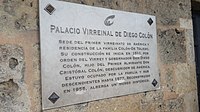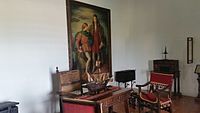Alcázar de Colón
| UNESCO World Heritage Site | |
|---|---|
 Alcázar de Colón seen from the Ozama River | |
| Location | Santo Domingo, Dominican Republic |
| Part of | Colonial City of Santo Domingo |
| Criteria | Cultural: (ii), (iv), (vi) |
| Reference | 526 |
| Inscription | 1990 (14th Session) |
| Coordinates | 18°28′39″N 69°52′58″W / 18.4775°N 69.8828°WCoordinates: 18°28′39″N 69°52′58″W / 18.4775°N 69.8828°W |
 Location of Alcázar de Colón in the Dominican Republic | |
The Alcázar de Colón, or Columbus Alcazar is the first fortified Spanish palace built in the Americas. It is located in the Dominican Republic's colonial area of Santo Domingo city, and forms part of the Ciudad Colonial UNESCO's World Heritage Site. It was built between 1511 and 1514 mostly in a Gothic and Renaissance style.
It is the only known residence of a member of the Christopher Columbus family in the New World,[1] his first-born son Diego Columbus, whose children Juana, Isabel, Luis and Christopher were born in the palace. Diego Columbus died in Spain in 1526 but María Álvarez de Toledo, his widow, remained there until her death in 1549. Three generations of the Columbus family inhabited the residence, possibly until the late 16th century.
The Tapestry collection (spanning from the 15th to 17th centuries) is particularly important and unique in the Caribbean, and includes pieces produced by the Flemish Van Den Hecke family from cartouches created by Charles Le Brun.[2] The Alcázar is the most visited museum in Santo Domingo.[3]
History[]
Some of the most famous Spanish Conquistadors such as Hernán Cortés and Pedro de Alvarado visited the residence. During the early Spanish colonial period, the mansion occupied a very important place in history. It was from here that many expeditions of conquest and exploration were planned. In 1586, the palace was captured and looted by the British pirate Sir Francis Drake and his forces who took many valuables with them.
As the influence of Santo Domingo declined, the house fell into ruins, and by the mid-18th century was abandoned and in danger of rotting away. Originally the residence had 55 rooms, of which only 22 remain. Eventually it was abandoned and the passage of time began to wreak havoc on the structure of the palace. By 1776 the building was in ruins and was nearly turned it into a prison, a project that was not carried out.
Almost a century later in 1870 it was declared a National Monument and the Dominican government eventually restored the palace. It was rescued and restored between 1955 and 1957, being transformed into a 22 rooms museum filled with period furniture, artwork, and other accessories. A self-guided tour using a portable audio speaker that discusses each room's function is available in various languages.
Architecture[]
The building was constructed using masonry made of coral rocks. It was built on a plot close to the rock islet that look towards the Ozama River, granted to Diego Columbus, firstborn son of the discoverer of the Americas, Christopher Columbus, by King Ferdinand II of Aragon, to build a dwelling for him and his descendants on the island Hispaniola, to which he arrived in 1509 as governor. The building houses the Museo Alcázar de Diego Colón, whose collection exhibits the Caribbean's most important ensemble of European late medieval and Renaissance works of art, which were acquired in the 1950s.
The palace is an impressive construction of coralline blocks that once housed some fifty rooms and a number of gardens and courtyards, although what remains today is about half the size it once was. It was built under Diego Colón, the son of Christopher Columbus; when he became the 4th Governor of the Indies in 1509, he ordered the construction of a family home and governor’s mansion between 1510 and 1512. The architectural style is gothic mudejar typical of the early 16th century.
Gallery[]
Exterior[]

Alcazar de Colon historical marker


As seen from the south

Alcazar de Colon window

Alcazar de Colon balcony
Interior[]

Alcazar de Colon interior

See also[]
- Captaincy General of Santo Domingo
- Ciudad Colonial (Santo Domingo)
- History of the Dominican Republic
References[]
- ^ "ALCAZAR DE COLON, COLONIAL CITY OF SANTO DOMINGO". dehovi.com.
- ^ Moisés de Soto David. "Archived copy. EL ANIMAL EN LOS TAPICES DEL ALCÁZAR". Pontificia Universidad Católica Madre y Maestra. Archived from the original on 2009-10-15. Retrieved 2009-12-26.
- ^ "Archived copy". Archived from the original on 2010-02-10. Retrieved 2009-12-26.CS1 maint: archived copy as title (link)
External links[]
| Wikimedia Commons has media related to Alcázar de Colón. |
- Buildings and structures in Santo Domingo
- Museums in the Dominican Republic
- Columbus family
- Spanish Colonial architecture in the Dominican Republic
- Tourist attractions in Santo Domingo
- Ciudad Colonial (Santo Domingo)













